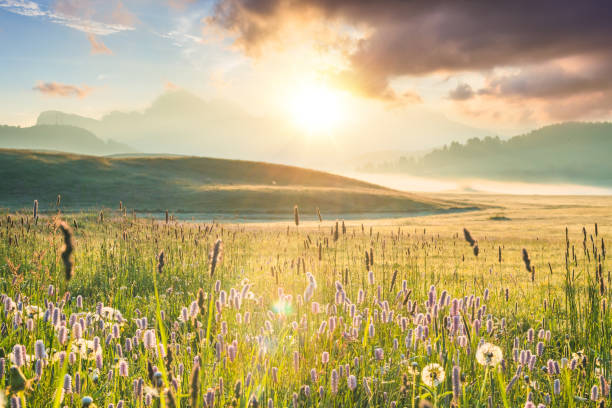How to Describe a Meadow in a Story (06 Best Tips)
In the vast canvas of storytelling, the setting serves as more than just a backdrop; it becomes a character in its own right, shaping the narrative and evoking emotions within the reader. Among the myriad of natural landscapes, the meadow stands as a timeless symbol of tranquility, vitality, and beauty.
Yet, capturing the essence of a meadow in words requires more than mere description—it demands a delicate blend of observation, imagination, and craftsmanship.
In this guide, we will embark on a journey to uncover the secrets of how to describe a meadow in a story, exploring the nuances of language, imagery, and character interaction that bring this idyllic landscape to life on the page.
From the gentle sway of wildflowers to the whisper of the breeze through the grass, each element contributes to the rich tapestry of sensory detail that immerses the reader in the vibrant world of the meadow.
So, let us venture forth into the boundless expanse of imagination and discover the art of storytelling amidst the serene beauty of the meadow.
How to Describe a Meadow in a Story
Here’s a step-by-step process for describing a meadow in a story:
Setting the Scene
Begin by setting the stage for your description. Mention the time of day, weather conditions, and any relevant contextual details.
For example: “As the morning sun rose over the horizon, casting a warm glow across the landscape, a gentle breeze danced through the meadow, carrying the scent of wildflowers.”
Visual Details
Describe the visual aspects of the meadow. Paint a vivid picture by mentioning the colors, shapes, and sizes of the various elements within the meadow.
For instance: “The meadow stretched out before them, a vast expanse of lush green grasses swaying in the breeze. Specks of vibrant wildflowers dotted the landscape, splashes of color against the sea of green.”
Soundscape
Incorporate auditory details to bring the scene to life. Describe the sounds one might hear in the meadow, such as the rustle of grasses, the chirping of birds, or the buzzing of insects.
For example: “The melody of birdsong filled the air, accompanied by the gentle rustle of grasses as small creatures scurried through the underbrush.”
Sensory Experience
Engage the reader’s senses by describing the tactile and olfactory sensations of being in the meadow. Mention the feel of the grass beneath one’s feet and the scent of the flowers in the air.
For instance: “As they stepped into the meadow, the soft blades of grass tickled their bare feet, and the sweet perfume of wildflowers enveloped them in a comforting embrace.”
Wildlife
Introduce any wildlife that inhabits the meadow. Describe the creatures one might encounter, such as butterflies flitting from flower to flower or rabbits darting through the grass.
For example: “Among the wildflowers, butterflies danced on delicate wings, while rabbits darted in and out of their burrows, playing a game of hide-and-seek amidst the tall grass.”
Emotional Impact
Convey the emotional impact of the meadow on your characters or narrator. Reflect on the feelings evoked by the serene beauty of the landscape.
For instance: “Standing in the midst of the meadow, they felt a sense of tranquility wash over them, a feeling of peace and contentment in the embrace of nature’s beauty.”
By following these steps, you can effectively describe a meadow in your story, immersing your readers in its natural splendor.

Understanding Meadows
Unlocking the secrets of a meadow is akin to embarking on a mystical journey through nature’s kaleidoscope. Meadows are not mere patches of grass; they are living, breathing ecosystems teeming with an abundance of life and color.
From the gentle sway of wildflowers dancing in the breeze to the symphony of chirping insects orchestrating the air, each meadow holds its own story waiting to be discovered.
Delve deeper, and you’ll find a tapestry woven with the intricate threads of biodiversity, where every blade of grass serves as a canvas for nature’s masterpiece. Understanding meadows isn’t just about recognizing their physical attributes but immersing oneself in their ethereal essence—a journey that promises enlightenment and awe at every turn.
Definition and Characteristics
Meadows, serene and picturesque, are verdant expanses of land characterized by their lush carpet of grasses and wildflowers, often nestled between woodlands or flanked by rolling hills.
Unlike dense forests or barren deserts, meadows exude an inviting openness, inviting wanderers to bask in their tranquility.
These vibrant ecosystems boast a rich tapestry of plant life, from delicate daisies to resilient clover, each species contributing to the meadow’s diverse and captivating allure. Meadows are also home to a plethora of wildlife, serving as vital habitats for insects, birds, and small mammals.
With their gentle slopes and undulating terrain, meadows offer a harmonious blend of beauty and functionality, acting as vital sources of food, shelter, and sustenance for both flora and fauna alike.
Seasonal Changes and Variations
Seasons weave their enchanting magic across the canvas of meadows, each bringing its own distinct palette of colors and moods. In spring, meadows awaken from their winter slumber, bursting forth with a symphony of blossoms and fresh greenery.
Wildflowers dot the landscape like vibrant confetti, while newborn wildlife frolic amidst the burgeoning foliage.
As summer unfolds, meadows reach their peak vitality, bathed in the golden glow of sunshine. Bees hum lazily among the blooming flowers, and butterflies flutter in a delicate ballet, painting the air with their iridescent wings.
Autumn casts a spell of transformation, as meadows don a cloak of fiery hues and rustic tones. Leaves dance on the breeze, and the air is filled with the earthy scent of fallen foliage. Finally, winter descends, blanketing meadows in a hushed stillness.
Frost glitters like diamonds on the grass, and the landscape lies dormant, patiently awaiting the promise of spring’s renewal. Throughout the changing seasons, meadows stand as timeless witnesses to the eternal cycle of nature’s beauty and resilience.
Pre-Writing Preparation
Preparing to capture the essence of a meadow in words is akin to orchestrating a symphony of senses, requiring a delicate balance of observation, imagination, and reverence for the natural world.
Before pen meets paper, one must embark on a pilgrimage of the senses, immersing themselves in the sights, sounds, and scents that define the meadow’s soul.
It begins with a journey of research, delving into the ecological intricacies and seasonal nuances that shape these verdant landscapes.
Yet, true understanding arises not merely from scholarly pursuits but from the intimate communion with nature itself.
Step into the meadow, feel the earth beneath your feet, listen to the rustle of grasses in the breeze, inhale the perfume of wildflowers carried on the wind.
Let the colors, textures, and rhythms of the meadow wash over you like a tidal wave of inspiration, igniting the spark of creativity within.
For in this sacred dance between observer and observed lies the alchemy of pre-writing preparation—a process that transcends mere planning to become a pilgrimage of the heart and mind.
Crafting Descriptive Language
Crafting descriptive language is akin to being an artist wielding a brush upon the canvas of the reader’s imagination. Each word becomes a brushstroke, imbued with the power to evoke vivid images, sensations, and emotions.
It’s not merely about selecting the right words but infusing them with a symphony of sensory detail and nuance.
Like a sculptor shaping clay, the writer molds language to capture the essence of the meadow: the velvety texture of grass underfoot, the kaleidoscope of colors dancing in the sunlight, the symphony of sounds echoing through the air.
It’s about painting with words, creating a tapestry of imagery that transports the reader to the heart of the meadow, where they can feel the gentle caress of a breeze and hear the whispered secrets of nature.
Crafting descriptive language is an art form unto itself, a delicate dance between precision and poetry that leaves an indelible imprint upon the reader’s soul.
Choosing the Right Words
Choosing the right words is akin to selecting gems from a treasure trove, each one possessing its own unique brilliance and allure. In the realm of describing a meadow, the selection process is akin to a delicate dance between precision and poetry.
It’s not merely about finding synonyms; it’s about unearthing the perfect word that captures the essence of a particular shade of green, the fragrance of a specific wildflower, or the softness of a gentle breeze.
Each word carries weight, texture, and color, shaping the reader’s perception and inviting them deeper into the sensory tapestry of the meadow.
Whether it’s a vibrant “azure” sky stretching overhead or the delicate “whisper” of wind through the grass, every word serves as a brushstroke, adding layers of depth and richness to the descriptive tableau.
Thus, in the art of choosing the right words, the writer becomes a master craftsman, weaving a spellbinding tapestry of imagery and emotion that lingers in the reader’s mind long after the page has turned.

Painting a Picture with Imagery
Painting a picture with imagery is the alchemy of transforming words into vibrant scenes that dance in the reader’s mind.
It’s about weaving a tapestry of sensations, colors, and sounds so vivid that the reader can almost feel the soft caress of the grass beneath their fingertips and hear the chorus of birdsong echoing through the air.
With each carefully chosen detail, the writer breathes life into the meadow, inviting the reader to step into its lush embrace.
From the sun-kissed petals of wildflowers swaying in the breeze to the dappled patterns of light and shadow playing across the landscape, every element is rendered with exquisite precision and nuance.
Through the magic of imagery, the meadow ceases to be mere words on a page; it becomes a living, breathing world that unfolds before the reader’s eyes, a sanctuary of beauty and wonder waiting to be explored.
Creating Sensory Harmony
Creating sensory harmony is the art of orchestrating a symphony of sensations that resonate harmoniously within the reader’s mind.
In the lush expanse of a meadow, it’s about striking a delicate balance between the myriad stimuli that define the experience: the sight of sunlight filtering through swaying grasses, the sound of a babbling brook weaving its melody through the air, the scent of wildflowers carried on a gentle breeze, the touch of soft petals brushing against skin, and the taste of the earthy sweetness lingering on the tongue.
Each sense contributes its unique melody to the symphony, yet it’s the harmonious interplay between them that creates a multisensory masterpiece.
Like a conductor guiding an orchestra, the writer must carefully blend these sensory elements, ensuring that each note resonates in perfect harmony with the others.
Through this sensory symphony, the meadow springs to life in the reader’s imagination, enveloping them in a world of beauty, wonder, and enchantment.
Structuring the Description
Structuring the description of a meadow is akin to crafting a meticulously choreographed dance, where each movement flows seamlessly into the next, captivating the reader with its rhythm and grace.
It begins with setting the stage, establishing the panoramic vista of the meadow with broad strokes, painting a sweeping canvas of rolling hills and sun-dappled fields.
Then, like a camera zooming in for a closer look, the focus narrows to reveal the intricate details: the delicate lacework of wildflowers swaying in the breeze, the intricate patterns of light and shadow playing across the landscape.
Structuring the description is not just about painting a static picture but imbuing it with a sense of movement and dynamism, guiding the reader on a journey through the meadow’s ever-changing tapestry.
It’s about striking the perfect balance between the macroscopic and microscopic, the panoramic and intimate, weaving a narrative that unfolds like a mesmerizing tapestry, each thread adding depth and richness to the overall composition.
In this carefully crafted structure lies the power to transport the reader to the heart of the meadow, where they can lose themselves in its beauty and wonder.
Enhancing Descriptions with Literary Devices
Enhancing descriptions with literary devices is akin to infusing a meadow with the magic of a fairy tale, transforming mere words into a kaleidoscope of imagery that dances in the reader’s imagination.
Like an alchemist wielding a wand, the writer employs an array of literary devices to weave a spellbinding tapestry of sensations and emotions.
Metaphors and similes become the paintbrushes with which the writer colors the landscape, likening the swaying grass to a sea of emerald waves or the chirping birds to a chorus of angels. Personification breathes life into the meadow, endowing the whispering wind with a voice and the murmuring brook with a personality all its own.
Alliteration and assonance add a musical cadence to the prose, echoing the rhythm of the meadow itself. Through the judicious use of literary devices, the writer transforms description into poetry, inviting the reader to lose themselves in a world where the ordinary becomes extraordinary and the mundane takes on a shimmering beauty all its own.
Incorporating Character Interaction
Incorporating character interaction into the depiction of a meadow is akin to choreographing a pas de deux between humanity and nature, where each step reveals a deeper understanding of the other.
Characters in a meadow aren’t just observers; they are participants in a dance of life, their presence shaping and being shaped by the natural world around them.
Whether it’s a child’s delighted laughter as they chase butterflies through the wildflowers or an elderly couple holding hands as they stroll along a sun-dappled path, each interaction adds layers of depth and resonance to the scene.
Through their eyes, the reader experiences the meadow anew, seeing its wonders through the lens of human emotion and experience.
Yet, amidst this dance, there is also a sense of humility and reverence, as characters are reminded of their place within the vast and ancient tapestry of nature.
In the meadow, humanity finds not just beauty and solace but also a profound sense of connection to something greater than themselves, a reminder that we are all but fleeting guests in a world that existed long before us and will continue long after we are gone.
Interaction with the Setting
Interaction with the setting is the intricate dance between characters and their environment, where the landscape becomes more than just a backdrop but an active participant in the unfolding narrative.
In the embrace of a meadow, characters find themselves engaged in a dialogue with the natural world, their actions and emotions influenced by the ever-shifting tapestry of flora and fauna around them.
Whether it’s the thrill of discovery as they stumble upon a hidden glade or the hushed reverence inspired by the majesty of a towering oak tree, every interaction deepens their connection to the land and enriches their journey.
Through their engagement with the setting, characters are transformed, their experiences colored by the sights, sounds, and scents of the meadow, shaping their perceptions and leaving an indelible imprint on their souls.
Dialogue and Reflection
Dialogue and reflection within the context of a meadow weave a tapestry of introspection and connection, where characters engage in a poignant exchange with both themselves and the natural world around them.
Amidst the tranquil beauty of the meadow, conversations take on a deeper resonance, echoing the whisper of the wind through the grass and the gentle murmur of the nearby brook.
Through dialogue, characters reveal their innermost thoughts, dreams, and fears, sharing intimate reflections that resonate with the reader’s own experiences.
Yet, amidst the chatter, there are also moments of silence, where characters pause to reflect upon the beauty and wonder surrounding them.
In these quiet moments, the meadow becomes a mirror, reflecting back their deepest truths and inviting them to confront the complexities of their own existence.
Through dialogue and reflection, characters not only deepen their connection to the setting but also to each other, forging bonds that transcend the boundaries of time and space, and leaving an indelible mark upon the landscape of their souls.
Frequently Asked Questions (FAQ) about How to Describe a Meadow in a Story
How do I make my meadow description stand out from others?
To create a distinctive meadow description, focus on incorporating unique sensory details that engage the reader’s imagination. Think beyond the visual and consider the sounds, scents, textures, and even tastes that characterize the meadow.
How can I convey the mood or atmosphere of the meadow effectively?
The mood of a meadow can vary widely depending on factors like weather, time of day, and seasonal changes.
Utilize descriptive language, such as vivid metaphors and evocative imagery, to capture the mood you wish to convey, whether it’s the peaceful tranquility of a sun-drenched afternoon or the eerie mystery of a mist-shrouded dawn.
Should I focus on specific flora and fauna in my description, or provide a more general overview?
Both approaches can be effective, depending on the tone and purpose of your story. For a more immersive experience, consider highlighting specific plant species, wildlife, or natural features that are characteristic of the meadow you’re describing.
However, if brevity or a broader perspective is desired, a general overview can still paint a vivid picture of the meadow’s essence.
How do I balance descriptive detail with advancing the plot or character development?
Descriptive passages should enhance rather than detract from the narrative flow of your story. Integrate descriptions seamlessly into scenes where they contribute to character development, mood setting, or thematic resonance.
Use sensory details to evoke emotions or insights relevant to the plot, ensuring that your meadow description serves a purpose beyond mere aesthetic appeal.
What role does perspective play in describing a meadow?
Perspective can greatly influence the reader’s perception of the meadow. Experiment with different narrative viewpoints, such as first-person, third-person limited, or omniscient, to convey varying levels of intimacy and distance.
Consider how your chosen perspective shapes the reader’s understanding of the meadow and its significance within the story.
Are there any common pitfalls to avoid when describing a meadow?
One common pitfall is overloading the description with excessive detail or flowery language, which can overwhelm the reader and detract from the overall impact.
Additionally, be mindful of clichés or stereotypes that may flatten the richness of your portrayal. Strive for authenticity and originality in your depiction of the meadow, drawing inspiration from personal experiences or careful research.
Conclusion
In the tapestry of storytelling, the depiction of a meadow serves as a canvas upon which the writer paints vivid landscapes of imagination and emotion.
Through the careful selection of descriptive language, the incorporation of sensory detail, and the skillful integration of character interaction, a meadow can transcend mere scenery to become a living, breathing entity within the narrative.
As we conclude this exploration into how to describe a meadow in a story, it becomes evident that the art lies not only in capturing the physical beauty of the landscape but also in harnessing its symbolic power to enrich the thematic depth and emotional resonance of the tale.
By mastering the techniques outlined in this guide and embracing the boundless possibilities of creative expression, writers can unlock the transformative potential of the meadow, inviting readers to embark on a journey of wonder, discovery, and enchantment.
So, let us continue to wander through the verdant meadows of our imagination, where every blade of grass whispers a story waiting to be told.






